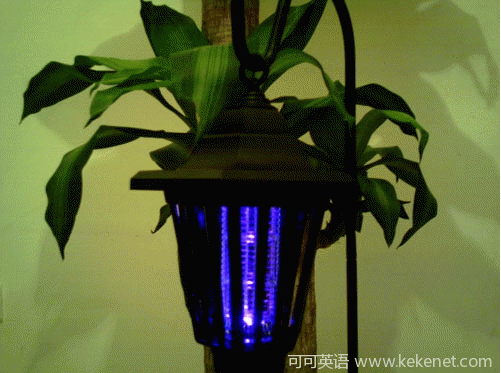(单词翻译:单击)

Science and Technolgy.
科技。
Photoelectric cells.
光电池。
To dye for.
染料光电池。
A new type of cell may bring "solar" energy indoors.
一种新型电池有望将"太阳能"引进室内。
THE phrase "indoor solar power" sounds like an oxymoron. But there is growing interest in the idea of using photoelectric cells to run gadgets as well as power grids-and doing so even when those gadgets are inside buildings. Much of the light these cells used would, of necessity, come from incandescent bulbs, fluorescent tubes and light-emitting diodes (LEDs) rather than through the window from the sun. But if the right sorts of cells were available this could be cheaper than constantly replacing the batteries that currently power electronic gizmos.
"室内太阳能"这词听着像个冤亲词。但是人们却对利用光电池为电子产品及电网供电(即便电子产品位于室内)这个想法兴趣渐浓。当然,这种电池所用的光大部分来自白炽灯、荧光灯及LED灯,而非透过窗户照进来的阳光。若有适合的光电池能替代目前电子产品所用的要经常更换的电池,那用电成本将会降低。
On April 8th G24 Innovations, a firm based in Wales, announced that it may have come up with just such a cell. The latest version of its special, dye-based photoelectric devices has set a new record for the conversion of light from bulbs into electricity: an efficiency of 26%, compared with the 15% which previous ones can manage. That lifts dye-based cells to the point where they might be widely deployable for indoor power.
4月8日,总部位于威尔士的G24创新公司宣布他们可能已经发明出这种电池:公司最新的特制染料光电器件已创下白炽灯光转换为电能的效率新记录:26%,而以前的器件转换效率仅为15%。这使染料电池有望广泛应用至室内发电中。
Dye-based cells are similar to the silicon-based variety found on rooftops around the world in that both rely on a semiconductor to assist the conversion of luminous energy into the electrical sort. The difference is that in the case of silicon cells, this conversion happens directly. That means the frequency of light absorbed is constrained by the physical properties of silicon itself.
染料电池类似于安装在世界各地屋顶上的硅光电池,两者都靠半导体器件将光能转换为电能。它们的区别在于,硅光电池是直接将光能转换为电能的,即受硅的物理性质限制,它只能吸收特定频率的光。
In the case of dye-based cells, which were invented at the Federal Polytechnic School of Lausanne, in Switzerland, in the 1990s, the light is first captured by molecules of a photosensitive dye. Tinker with the composition of this dye and you change the frequency of light that can be captured. This makes dye-based cells more flexible than silicon ones.
而在染料电池中,光会先被光敏染料的分子捕获。染料电池是在上世纪90年代由瑞士洛桑联邦理工学院发明的。稍微改变一下这种染料的成分,就可以让它吸收另一种频率的光。这个特性使染料电池比硅光电池更加灵活。
The dye molecules themselves are bound to tiny particles of titanium dioxide, a less-famous (but cheaper) semiconductor than silicon, and the whole assembly is immersed in an electrolyte and sandwiched between two electrodes. When a photon of light is absorbed by a dye molecule, an electron is knocked into the titanium dioxide. From there it travels to one of the electrodes and a current is thus generated.
光敏染料分子本身附着在二氧化钛微粒上,二氧化钛是种半导体,没有硅那么广为人知(但更便宜)。整个附着过程都是在电解液里两个电极之间进行的。当一个染料分子吸收一个光子时,一个电子就会受到碰撞,进入二氧化钛中。电子从那里向其中一个电极运动,由此产生电流。
The flexibility brought by the dye-based approach makes this sort of cell particularly useful indoors. Silicon-based solar cells have been optimised for sunlight. But artificial light, whether of the incandescent, fluorescent or LED variety, contains a different mixture of frequencies from that put out by the sun. By changing the composition of the dye, G24's engineers ensure that the maximum sensitivity of the cell coincides with whatever frequency mix is appropriate for the artificial light concerned.
染料电池的这种灵活性让其特别适用于室内,硅光电池则已被优化至最有利于吸收阳光。但人造光(不论是白炽灯、荧光灯还是LED灯的光)的光谱都和阳光的不同。通过改变所用染料的成分,G24的工程师保证了光电池的最大感光度与特定场合使用的适当的人造光源的光谱相吻合。
Besides being tweakable to match the spectrum of a light-bulb, dye-based cells also work well in dim or diffuse light of the sort often found indoors. Silicon-based systems do not. And dye-based cells, having no rigid parts, can bend, and are mechanically robust compared with the silicon sort. That gives them a further advantage over silicon cells, especially for powering consumer gadgets.
除了能够稍作调整以适应灯泡的光谱外,染料电池还能在昏暗的环境或漫反射光照射下(常见于室内)正常工作,硅光电池则不然。而且染料电池没有刚性部件,可弯曲,与硅电池相比更为结实耐用。这让它们比硅光电池又多了一项优势,尤其是在为消费电子产品供电方面。
Steven Burt, G24's chief financial officer, talks of light-bulb-powered TV remote controls, smoke detectors and computer keyboards. (A non-removable internal battery would store charge for use when the lights are off.) The company already offers prototypes of bags and jackets with photosensitive panels woven in, designed to charge digital cameras and mobile phones, and a hotel in Las Vegas is using G24's products to run its electric window-blinds. Mr Burt also sees a market for powering the networks of sensors needed to monitor things like temperature and humidity in modern "smart" buildings.
G24的财务总监史蒂芬?伯特(Steven Burt)谈到了用灯泡供电的电视遥控器、烟雾探测器和电脑键盘。(内置一个固定电池储存电能以在关灯后供电。)该公司已推出内部装有光敏电池板的夹克和背包样品,用来为数码相机和手机充电。现在,拉斯维加斯的一家酒店使用了G24的产品来为其电动百叶窗供电。史蒂芬?伯特还认为染料电池在为现代"智能"建筑中的传感器网络(用于监测温度、湿度等)供电方面很有市场。
Eventually, says Mr Burt, the ability of dye-based cells to produce useful quantities of power even in dim and diffuse light could see them used outside, perhaps on rooftops in cloudier parts of the world-a market at present dominated by traditional, silicon-based cells, even though they are not well-suited to the purpose. But for now, G24's factory in Cardiff, not a city known for its sunshine, remains powered by a wind turbine.
史蒂芬?伯特说,在昏暗或漫反射光环境里染料电池也能产生足够的电量,最终这种性能会让它们能够应用于室外,可能是装在云层较厚的地区的屋顶上。这个市场目前是由传统的硅光电池主导,虽然它们并不适合在昏暗环境下工作。只不过,G24公司位于加的夫这个日照不多的城市的工厂如今却仍然依靠风力涡轮机发电。


